- Kenmore refrigerator water filters
- Whirlpool refrigerator water filters
- Samsung refrigerator water filters
- GE refrigerator water filters
- LG refrigerator water filters
- Frigidaire refrigerator water filters
- KitchenAid refrigerator water filters
- Maytag refrigerator water filters
- Kenmore Elite refrigerator water filters
- Estate refrigerator water filters
- GE Profile refrigerator water filters
- Amana refrigerator water filters
- Bosch refrigerator water filters
- Dacor refrigerator water filters
- Electrolux refrigerator water filters
Electric Cooktop: Why doesn't my electric cooktop's surface element heat?
On an electric cooktop that uses surface element switches to control the elements, a failed surface element switch can prevent the surface element from heating. On electronically-controlled cooktops, a failed surface element relay on the electronic control board that controls surface elements can keep a surface element from heating.
No matter which type of control your cooktop uses, a broken surface element won't heat. If your cooktop uses coil surface elements, examine the element that isn't heating and replace the coil element if you see a cracked or broken coil. Radiant surface elements are harder to check for damage because they're under the glass cooktop. Unplug the cooktop and remove the burner box to access and check a radiant surface element that isn't heating. Replace the surface element if you see a break in the ribbon element.
A radiant surface element has a limiter switch that cycles the radiant element off to protect the ceramic glass cooktop from overheating. A failed limiter switch won't allow the radiant element to heat. Disconnect electric power to the cooktop and check for continuity through the limiter switch using a multimeter. You should measure near 0-ohms of resistance through the limiter switch indicating that the switch is allowing current to flow through the element. If you measure OL or "open load" indicating that the switch isn't allowing current to flow through the element, then the limiter switch has failed. The limiter switch is often included with a radiant element but not always. Replace the limiter switch if it's a separate part and it's preventing the radiant surface element from heating. If the limiter isn't available as a separate part, replace the radiant surface element.

THESE REPAIRS MAY HELP SOLVE YOUR ELECTRIC COOKTOP PROBLEM

Replace the cooktop radiant surface element
A radiant surface element is mounted under the glass top. It provides the heat source for cooking. If the radiant surface element doesn't heat when you turn it on, replace it.
Cooktop radiant surface element
Find the required part specific to your product.
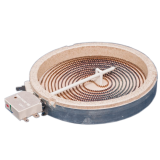
How to replace a radiant element on an electric cooktop
Learn how to replace a radiant element on an electric cooktop at Sears PartsDirect. Find out which parts and tools you need, get step-by-step instructions and more.
Repair difficulty
Time required
45 minutes or less

Replace the cooktop surface element switch
The surface element switch-also called a surface burner switch or infinite burner switch-turns on the heating elements on an electric cooktop. If the switch's electrical contacts fail, the switch might not turn the surface burner on or off, or it might not control the heat level of the burner.
Cooktop surface element switch
Find the required part specific to your product.
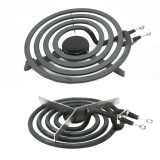
Replace the cooktop coil surface element
The coil surface element-also known as the coil element-plugs into the terminal block in an electric cooktop. It's controlled by a surface element switch (also called an infinite burner switch) and sits above a drip pan. It provides the heat for that location on the cooktop. Replace the coil surface element if it's physically damaged or won't heat.
Cooktop coil surface element
Find the required part specific to your product.
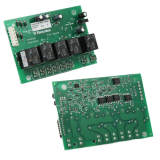
Replace the cooktop electronic control board
Some cooktops use an electronic control board to control the surface elements. If the electronic control board doesn't turn on a surface burner or the display panel or indicator lights don't light up, replace the electronic control board.
Cooktop electronic control board
Find the required part specific to your product.
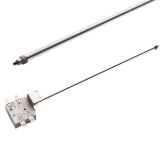
Replace the cooktop limiter on a radiant surface element
The radiant surface element has a limit switch that shuts off the element to protect the ceramic glass cooktop from overheating. That limiter is included with the element on some radiant surface elements, while on others it can be replaced as a separate component. If a surface element fails to heat, or the limiter is not regulating the maximum temperature properly, replace it.
Cooktop limiter on a radiant surface element
Find the required part specific to your product.
Was this information helpful?
Most common symptoms to help you fix your cooktops
Choose a symptom to see related cooktop repairs.
Main causes: lack of electrical power, gas supply failure, bad pressure regulator, control system failure…
Repair guides for electric cooktops
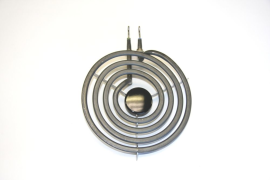
How to replace a coil surface element on an electric cooktop
Easily replace a coil surface element in 15 minutes or less by following these step-by-step instructions.…
Repair difficulty
Time required
15 minutes or less

How to replace the glass top on an electric cooktop
Don't use a cracked or damage glass cooktop—replace it, using these instructions to guide you.…
Repair difficulty
Time required
30 minutes or less
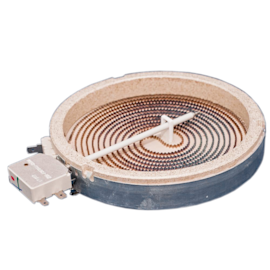
How to replace a radiant element on an electric cooktop
Follow these step-by-step instructions to replace a damaged radiant element on your electric cooktop when the element wo…
Repair difficulty
Time required
45 minutes or less
Effective articles & videos to help repair your cooktops
Use the advice and tips in these articles and videos to get the most out of your cooktop.

Get tips on completing essential holiday cleaning tasks to brighten your home.…
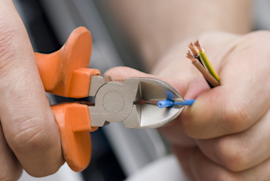
Learn how to repair broken, frayed or damaged wires in your appliances.…

These common questions can help you make the most of your cooktop.…